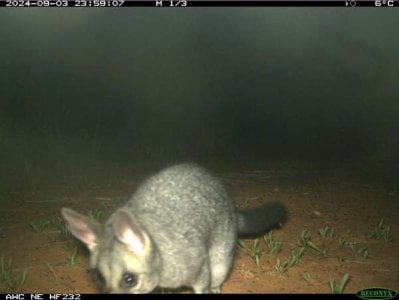See the Outback like never before – these shocking photos expose the truth that every city-dweller is completely missing!
By
Seia Ibanez
- Replies 3
Australia's outback is a land of stark beauty and rugged landscapes, often romanticized in literature and film. However, recent photographs from remote monitoring cameras have revealed a less known truth about this vast wilderness – a truth that many urban Australians may find surprising and concerning.
For the first time in ten years, cameras positioned around Cunnamulla, a remote town 750km west of Brisbane, have captured images of a creature many believed had disappeared from the area. The subject of these rare photographs is the common brushtail possum, a marsupial that is, ironically, thriving in coastal cities such as Melbourne, Sydney, Adelaide, and Brisbane.
Ecologist Dr Helena Stokes, while speaking to Yahoo News, highlighted a common misconception regarding the brushtail possum. Despite their apparent abundance in urban areas, these creatures have experienced a significant decline in the arid regions of the country. 'It's a deception that they're super common, and they have declined substantially from a large part of their range,' Dr. Stokes explained.

The common brushtail possum, a once widespread species, has vanished from 50 percent of its historical range since European settlement. Known for their adaptability, these possums typically feast on fruit and leaves but won't shy away from insects, bugs, worms, and eggs when the opportunity arises. Interestingly, they were introduced to New Zealand to kickstart a fur industry, but have since become a pest there due to their destructive impact on native flora and fauna.
The plight of the brushtail possum is not an isolated case. Across Australia, numerous once-abundant animals are now facing alarming declines. Koalas have been listed as endangered in New South Wales, Queensland, and the Australian Capital Territory, with significant threats looming in Victoria and South Australia. The Bogong moth, once seen in the billions, is now endangered, and the festive sight of Christmas beetles has become a rarity.
Localised extinction is a stark reality for many species, including the common wombat and both the western grey and eastern grey kangaroos. These animals are being pushed out by the relentless march of urban development, as new housing estates encroach on the farmlands they once roamed freely.
The challenges facing the brushtail possum are multifaceted. While only one individual has been detected in the recent Cunnamulla survey, researchers from the Australian Wildlife Conservancy (AWC) are diligently searching for more signs of their presence. The detected possum, spotted in September, may have been merely passing through rather than settling in the town.
The decline of the common brushtail possum is not unique to Queensland. In the Northern Territory, the AWC has reintroduced 40 individuals to a 9,540-hectare predator-proof sanctuary at Newhaven, where they had not been seen for 60 years. The northern brushtail possum, a relative of the common brushtail, is faring even worse, listed as vulnerable to extinction. Despite this, habitat destruction continues as the government clears land for new housing projects.
Dr. Stokes believes that the issues facing brushtail possums are consistent across Australia. Predation by feral animals such as foxes and cats, habitat clearing, and the impacts of a hotter, drier climate are all contributing factors to their decline.
As Australians, we take pride in our unique and diverse environment. Yet, these shocking photos from the outback serve as a stark reminder that the health of our ecosystems is not guaranteed. It's a call to action for all of us, especially city-dwellers who may not witness these changes firsthand, to become more aware and involved in conservation efforts.

We must ask ourselves: Are we willing to see more of our native wildlife vanish before our eyes, or will we take a stand to protect the natural heritage that makes Australia so wonderfully unique? Share your thoughts and join the conversation about preserving our country's wildlife and wild places.
For the first time in ten years, cameras positioned around Cunnamulla, a remote town 750km west of Brisbane, have captured images of a creature many believed had disappeared from the area. The subject of these rare photographs is the common brushtail possum, a marsupial that is, ironically, thriving in coastal cities such as Melbourne, Sydney, Adelaide, and Brisbane.
Ecologist Dr Helena Stokes, while speaking to Yahoo News, highlighted a common misconception regarding the brushtail possum. Despite their apparent abundance in urban areas, these creatures have experienced a significant decline in the arid regions of the country. 'It's a deception that they're super common, and they have declined substantially from a large part of their range,' Dr. Stokes explained.

Remote monitoring cameras have captured images of the common brushtail possum in Cunnamulla. Credit: AWC
The common brushtail possum, a once widespread species, has vanished from 50 percent of its historical range since European settlement. Known for their adaptability, these possums typically feast on fruit and leaves but won't shy away from insects, bugs, worms, and eggs when the opportunity arises. Interestingly, they were introduced to New Zealand to kickstart a fur industry, but have since become a pest there due to their destructive impact on native flora and fauna.
The plight of the brushtail possum is not an isolated case. Across Australia, numerous once-abundant animals are now facing alarming declines. Koalas have been listed as endangered in New South Wales, Queensland, and the Australian Capital Territory, with significant threats looming in Victoria and South Australia. The Bogong moth, once seen in the billions, is now endangered, and the festive sight of Christmas beetles has become a rarity.
Localised extinction is a stark reality for many species, including the common wombat and both the western grey and eastern grey kangaroos. These animals are being pushed out by the relentless march of urban development, as new housing estates encroach on the farmlands they once roamed freely.
The challenges facing the brushtail possum are multifaceted. While only one individual has been detected in the recent Cunnamulla survey, researchers from the Australian Wildlife Conservancy (AWC) are diligently searching for more signs of their presence. The detected possum, spotted in September, may have been merely passing through rather than settling in the town.
The decline of the common brushtail possum is not unique to Queensland. In the Northern Territory, the AWC has reintroduced 40 individuals to a 9,540-hectare predator-proof sanctuary at Newhaven, where they had not been seen for 60 years. The northern brushtail possum, a relative of the common brushtail, is faring even worse, listed as vulnerable to extinction. Despite this, habitat destruction continues as the government clears land for new housing projects.
Dr. Stokes believes that the issues facing brushtail possums are consistent across Australia. Predation by feral animals such as foxes and cats, habitat clearing, and the impacts of a hotter, drier climate are all contributing factors to their decline.
As Australians, we take pride in our unique and diverse environment. Yet, these shocking photos from the outback serve as a stark reminder that the health of our ecosystems is not guaranteed. It's a call to action for all of us, especially city-dwellers who may not witness these changes firsthand, to become more aware and involved in conservation efforts.
Key Takeaways
- Remote monitoring cameras have captured images of the common brushtail possum in Cunnamulla, indicating its presence in an area where it was thought to have vanished.
- Ecologist Dr Helena Stokes highlights that the adaptation of the common brushtail possum to urban areas has obscured its significant decline in arid regions of Australia.
- Across Australia, once-abundant animals, including koalas, bogong moths, and Christmas beetles, are in decline with some facing localised extinction.
- The common brushtail possum faces threats from habitat destruction, feral predators like foxes and cats, and changes to the climate, leading to hotter and drier conditions.
We must ask ourselves: Are we willing to see more of our native wildlife vanish before our eyes, or will we take a stand to protect the natural heritage that makes Australia so wonderfully unique? Share your thoughts and join the conversation about preserving our country's wildlife and wild places.







